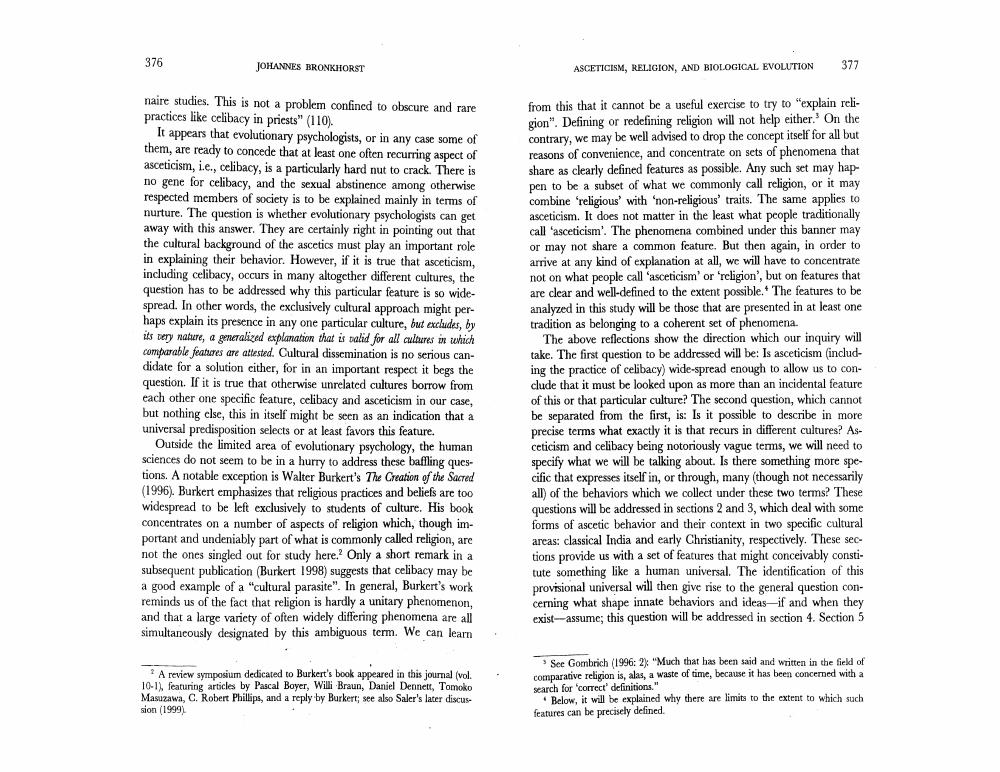Book Title: Asceticism Religion And Biological Evolution Author(s): Johannes Bronkhorst Publisher: Johannes Bronkhorst View full book textPage 2
________________ 376 JOHANNES BRONKHORST ASCETICISM, RELIGION, AND BIOLOGICAL EVOLUTION 377 naire studies. This is not a problem confined to obscure and rare practices like celibacy in priests" (110). It appears that evolutionary psychologists, or in any case some of them, are ready to concede that at least one often recurring aspect of asceticism, i.e., celibacy, is a particularly hard nut to crack. There is no gene for celibacy, and the sexual abstinence among otherwise respected members of society is to be explained mainly in terms of nurture. The question is whether evolutionary psychologists can get away with this answer. They are certainly right in pointing out that the cultural background of the ascetics must play an important role in explaining their behavior. However, if it is true that asceticism, including celibacy, occurs in many altogether different cultures, the question has to be addressed why this particular feature is so widespread. In other words, the exclusively cultural approach might perhaps explain its presence in any one particular culture, but excludes, by is very nature, a generalized explanation that is valid for all cultures in which comparable features are attested. Cultural dissemination is no serious candidate for a solution either, for in an important respect it begs the question. If it is true that otherwise unrelated cultures borrow from each other one specific feature, celibacy and asceticism in our case, but nothing else, this in itself might be seen as an indication that a universal predisposition selects or at least favors this feature. Outside the limited area of evolutionary psychology, the human sciences do not seem to be in a hurry to address these baffling questions. A notable exception is Walter Burkert's The Creation of the Sacred (1996). Burkert emphasizes that religious practices and beliefs are too widespread to be left exclusively to students of culture. His book concentrates on a number of aspects of religion which, though important and undeniably part of what is commonly called religion, are not the ones singled out for study here.? Only a short remark in a subsequent publication (Burkert 1998) suggests that celibacy may be a good example of a "cultural parasite". In general, Burkert's work reminds us of the fact that religion is hardly a unitary phenomenon, and that a large variety of often widely differing phenomena are all simultaneously designated by this ambiguous term. We can learn from this that it cannot be a useful exercise to try to "explain religion". Defining or redefining religion will not help either. On the contrary, we may be well advised to drop the concept itself for all but reasons of convenience, and concentrate on sets of phenomena that share as clearly defined features as possible. Any such set may happen to be a subset of what we commonly call religion, or it may combine religious' with 'non-religious' traits. The same applies to asceticism. It does not matter in the least what people traditionally call 'asceticism'. The phenomena combined under this banner may or may not share a common feature. But then again, in order to arrive at any kind of explanation at all, we will have to concentrate not on what people call 'asceticism' or 'religion', but on features that are clear and well-defined to the extent possible. The features to be analyzed in this study will be those that are presented in at least one tradition as belonging to a coherent set of phenomena. The above reflections show the direction which our inquiry will take. The first question to be addressed will be: Is asceticism (including the practice of celibacy) wide-spread enough to allow us to conclude that it must be looked upon as more than an incidental feature of this or that particular culture? The second question, which cannot be separated from the first, is: Is it possible to describe in more precise terms what exactly it is that recurs in different cultures? Asceticism and celibacy being notoriously vague terms, we will need to specify what we will be talking about. Is there something more specific that expresses itself in, or through, many (though not necessarily all) of the behaviors which we collect under these two terms? These questions will be addressed in sections 2 and 3, which deal with some forms of ascetic behavior and their context in two specific cultural areas: classical India and early Christianity, respectively. These sec tions provide us with a set of features that might conceivably constitute something like a human universal. The identification of this provisional universal will then give rise to the general question concerning what shape innate behaviors and ideas--if and when they exist--assume; this question will be addressed in section 4. Section 5 : ? A review symposium dedicated to Burkert's book appeared in this journal (vol. 10-1), featuring articles by Pascal Boyer, Willi Braun, Daniel Dennett, Tomoko Masuzawa, C. Robert Phillips, and a reply by Burkert, see also Saler's later discus sion (1999) See Gombrich (1996: 2% "Much that has been said and written in the field of comparative religion is, alas, a waste of time, because it has been concerned with a search for correct' definitions." Below, it will be explained why there are limits to the extent to which such features can be precisely defined.Page Navigation
1 2 3 4 5 6 7 8 9 10 11 12 13 14 15 16 17 18 19 20 21 22 23
